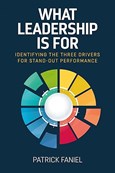- Leadership
Choosing What Leadership Is For
Patrick Faniel demonstrates the power of clear restricted focus and the danger of spreading leadership attention too thinly
In our complex fast-changing world, the pressure on business leaders can be enormous and relentless. Beyond delivering consistent financial results and providing a vision for future success, leaders are called on to champion inclusivity, environmental sustainability, social responsibility, and more. The most successful leaders can deliver all these things, but only if they first identify and emphasize a few key drivers of performance—ensuring this is where the organization is focused.

In his new book, What Leadership is for: Identifying the Three Drivers for Stand-out Performance, Patrick Faniel, Managing Director of Management Centre Europe (MCE), points out that there are as many as twelve worthy drivers of business performance that leaders should be aware of. Yet trying to commit to more than three of these is likely to dilute effort and detract from the business’s purpose.
A leader’s role is to provide a clear sense of direction and having too many competing priorities will only cause customer confusion, employee disengagement, and ultimately under-performance. McKinsey & Co report that less than 10% of leaders are satisfied with their company’s performance in terms of innovation, whereas 80% say innovation is one of their top priorities—a priority that is no doubt lost amongst a dozen others.
Faniel’s central message is that leaders must decide, bearing in mind their organization’s specific circumstance, where they and their team must train their focus—decide what their leadership is for. If, as he recommends, this is to be no more than on three drivers, it does not mean the other eight are ignored. If growth, customer service, and effectiveness are prioritized the company will still need strategy execution and to foster diversity and inclusion.
Faniel, who has previously led leading American companies in Europe, makes no judgement on the choice of drivers. He merely explains, using real world examples from the Levi Strauss to Porsche, how best to align the three key drivers that will propel the business forward, while keeping the other less targeted factors in play.
Having described the general concept, the core of the book analyses each of twelve drivers in depth, under four headings: Business (growth, innovation, partnerships); Process (strategy execution, effectiveness, digitalization); People (employee experience, diversity and inclusion, inspiration); and Market (customer focus, brands, personalization)—and provides a series of applicable models that can cascade down and inspire teams to a sense of distinct identity and purpose.
In a final chapter Faniel considers a phenomenon familiar to many executives—leadership without ‘authority.’ Post-command and control, in today’s less hierarchical organizations, where leadership is ‘distributed,’ the ‘three drivers’ model still applies—perhaps more than ever as people pull in different directions. The skills needed to focus members of the team and direct the organization in more democratic environments are people skills. Clear communication adapted according to the audience, flexible forms of influence, persuasion, the ability to inspire performance and emotional intelligence are critical. While we might hope everyone thinks rationally, they don’t or at least they don’t think the same way we do—influencing depends on understanding the power of emotions.
AI integration, risk management, developing corporate culture, ESG, cyber security and much else add to the list of leadership concerns, but they are not what leadership is for and do not in themselves drive the business. They are cogs in the engine but not the motor. This book is a useful reminder, in an increasingly complex business world, of the power of clear restricted focus and the danger of spreading leadership and organizational attention too thinly.
…………………………………………………………………………………………….........
DEVELOPING LEADERS QUARTERLY MAGAZINE AND WEEKLY BRIEFING EMAILS
































